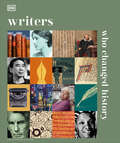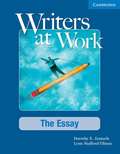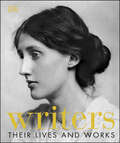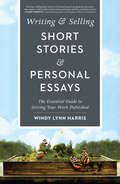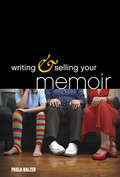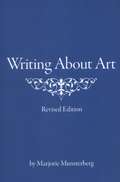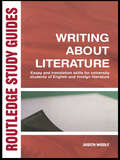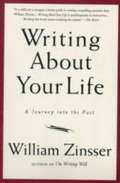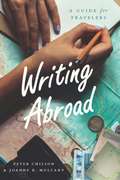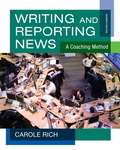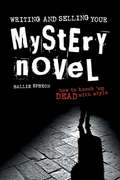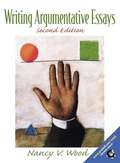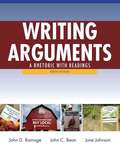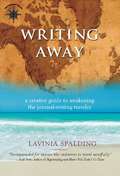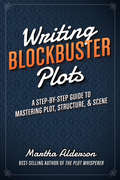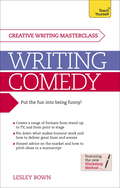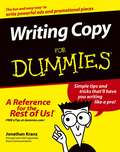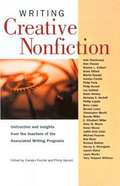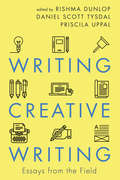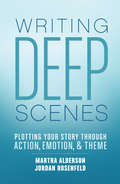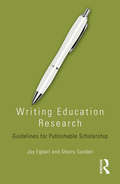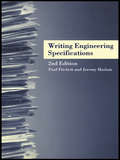- Table View
- List View
Writers Who Changed History (DK History Changers)
by DKExplore the fascinating lives and loves of the greatest novelists, poets, and playwrights.Lavishly illustrated with photographs and paintings of writers’ homes, studies, and personal artifacts—along with pages from original manuscripts, first editions, and their correspondence—Writers Who Changed History introduces the key ideas, themes, and literary techniques of each writer, revealing the imaginations and personalities behind some of the world’s greatest novels, short stories, poems, and plays.Introduced with a stunning portrait of each featured novelist, playwright, or poet, biographical entries trace the friendships, loves, and rivalries that inspired each individual and influenced their work, revealing insights into the larger-than-life characters, plots, and evocative settings that they created. Each entry explains how the person’s writing developed during their lifetime and sets it in context, conveying a powerful sense of the place and the period of history in which they lived.Covering an eclectic range of authors from the Middle Ages to the present day, Writers Who Changed History provides a compelling glimpse of the lives and loves of each great writer.
Writers at Work: The Essay
by Dorothy E. Zemach Lynn Stafford-YilmazThe Writers at Work series takes beginning to high intermediate-level writing students through a process approach to writing. The series is intended primarily for adults whose first language is not English, but it may also prove effective for younger writers or for native speakers of English who are developing their competence as independent writers in English.
Writers: Their Lives and Works (DK History Changers)
by DKExplore the fascinating lives and loves of the greatest novelists, poets, and playwrights.From William Shakespeare and Jane Austen to Gabriel García Márquez and Toni Morrison, Writers explores more than 100 biographies of the world&’s greatest writers. Each featured novelist, playwright, or poet is introduced by a stunning portrait, followed by photography and illustrations of locations and artifacts important in their lives – along with pages from original manuscripts, first editions, and their correspondence. Trace the friendships, loves, and rivalries that inspired each individual and affected their writing, revealing insights into the larger-than-life characters, plots, and evocative settings that they created. You will also uncover details each writer&’s most famous pieces and understand the times and cultures they lived in – see how the world influenced them and how their works influenced the world.Writers introduces key ideas, themes, and literary techniques of each figure, revealing the imaginations and personalities behind some of the world's greatest novels, short stories, poems, and plays. A diverse variety of authors are covered, from the Middle Ages to present day, providing a compelling glimpse into the lives of the people behind the page.
Writing & Selling Short Stories & Personal Essays: The Essential Guide to Getting Your Work Published
by Windy HarrisWrite It Short, Sell It Now Short stories and personal essays have never been hotter--or more crucial for a successful writing career. Earning bylines in magazines and literary journals is a terrific way to get noticed and earn future opportunities in both short- and long-form writing.Writing & Selling Short Stories & Personal Essays capitalizes on the popularity of these genres by instructing on the two key steps to publishing short works: crafting excellent pieces and successfully submitting them. You'll learn how to:Develop different craft elements--including point of view, character, dialogue, scene writing, and more--specifically for short stories and essays.Recognize the qualities of excellent short works, using examples from recently published stories and essays in major journals.Understand the business of writing short, from categorizing your work and meeting submission guidelines to networking and submitting to writing contests.Master the five-step process for submitting and selling like a pro.Featuring advice and examples from a multitude of published authors, Writing & Selling Short Stories & Personal Essays is a must-have for any writer's bookshelf.
Writing & Selling Your Memoir: How to Craft Your Life Story So That Somebody Else Will Actually Want to Read It
by Paula BalzerThere's more to writing a memoir than just writing your life story. A memoir isn't one long diary entry. Rather, it's a well-crafted story about a crucial, often exceptionally difficult, time in someone's life. Writing & Selling Your Memoirtalks readers through the process of telling their most personal stories in a compelling, relatable, and readable manner. Unlike other books dedicated to the art and craft of writing memoir, it teaches readers how to approach the genre with love, respect, and know-how without sentimentalizing it. Drawing on her experience working with New York Times best-selling memoirists, literary agent Paula Balzer carefully explores the genre and provides readers with step-by-step instruction on how to: Identify strong opening and closing points Find and develop a strong central hook that readers can relate to Structure a memoir to maximize readability Use dialogue and pacing to enhance intimacy Approach honesty and truthfulness Build a successful author platform around their memoir Get an agent's attention Get published Full of tips, techniques, detailed exercises, and examples from best-selling memoirs as well as sidebars from well-known memoir authors,Writing & Selling Your Memoirteaches you how to approach an often tricky genre and tell your story without sentimentalizing it.
Writing A Report, 9th Edition: How To Prepare, Write And Present Really Effective Reports
by John BowdenNow in its 9th edition, this extensively revised and updated handbook explains how you can write reports that will be: * Read without unnecessary delay * Understood without undue effort Accepted, and where applicable, acted upon / Divided into three parts, the book looks in detail firstly at the practical side of report writing: * Preparation and planning * Collecting and handling information * Writing and revising / Secondly, at the creative side of report writing: * Achieving a good style and choosing the correct words * Improving the overall appearance of reports / And thirdly at 23 common types of report, including: * Annual reports/ Appraisal reports * Audit reports Minutes/Progress reports * Student project reports/Technical reports / There is also an extensive glossary and a selection of sample reports.
Writing A Report, 9th Edition: How to prepare, write & present really effective reports
by John BowdenNow in its 9th edition, this extensively revised and updated handbook explains how you can write reports that will be: * Read without unnecessary delay * Understood without undue effort Accepted, and where applicable, acted upon / Divided into three parts, the book looks in detail firstly at the practical side of report writing: * Preparation and planning * Collecting and handling information * Writing and revising / Secondly, at the creative side of report writing: * Achieving a good style and choosing the correct words * Improving the overall appearance of reports / And thirdly at 23 common types of report, including: * Annual reports/ Appraisal reports * Audit reports Minutes/Progress reports * Student project reports/Technical reports / There is also an extensive glossary and a selection of sample reports.
Writing About Art (Revised Edition)
by Marjorie MunsterbergWriting About Art was written as the text for a course of the same name required of all art majors at The City College of New York. The book explains the different approaches college students encounter in undergraduate art history classes. Each chapter outlines the characteristics of one type of visual or historical analysis and briefly explains its history and development. Passages by well-known art historians provide examples of each method. Sample essays by students are accompanied by extensive explanations of suggested revisions. The book also includes a step-by-step guide to researching art historical topics and a section about correctly citing sources.
Writing About Literature: Essay and Translation Skills for University Students of English and Foreign Literature
by Judith WoolfWriting about Literature combines detailed practical and scholarly advice with a sense of the scope and creative possibilities of literary criticism, empowering the student reader to make his or her own discoveries and experiments with language. In addition, it gives valuable guidance on adult language learning and translation skills for students of foreign literature. This handy, accessible guide covers all aspects of the essay-writing process, including: preliminary reading and choosing and researching a topic referencing and presentation computer use style, structure, vocabulary, grammar and spelling the art and craft of writing scholarly and personal insights into the problems and pleasures of writing about literature. Written in an entertaining and informative way and containing a wealth of practical advice and scholarly insights, this wise, witty and helpful book should be on every literature student's bookshelf.
Writing About Your Life: A Journey into the Past
by William ZinsserOn Writing Well gives you the tools to organize and recover your past, and the confidence to believe in your life narrative. His method is to take you on a memoir of his own: 13 chapters in which he recalls dramatic, amusing, and often surprising moments in his long and varied life as a writer, editor, teacher, and traveler. Along the way, Zinsser pauses to explain the technical decisions he made as he wrote about his life.
Writing Abroad: A Guide for Travelers
by Peter Chilson Joanne B. Mulcahy“Tell me all about your trip!” It’s a request that follows travelers as they head out into the world, and one of the first things they hear when they return. When we leave our homes to explore the wider world, we feel compelled to capture the experiences and bring the story home. But for those who don’t think of themselves as writers, putting experiences into words can be more stressful than inspirational. Writing Abroad is meant for travelers of all backgrounds and writing levels: a student embarking on overseas study; a retiree realizing a dream of seeing China; a Peace Corps worker in Kenya. All can benefit from documenting their adventures, whether on paper or online. Through practical advice and adaptable exercises, this guide will help travelers hone their observational skills, conduct research and interviews, choose an appropriate literary form, and incorporate photos and videos into their writing. Writing about travel is more than just safeguarding memories—it can transform experiences and tease out new realizations. With Writing Abroad, travelers will be able to deepen their understanding of other cultures and write about that new awareness in clear and vivid prose.
Writing And Reporting News: A Coaching Method
by Carole RichPrepare yourself for the changing world of journalism with WRITING AND REPORTING NEWS: A COACHING METHOD, the book that integrates new trends in the convergence of print, broadcast and online media while teaching fundamental skills. With new information about social media, mobile media, blogs, and new skills you'll need for whatever career you choose, the seventh edition features tips, techniques, and real-life stories from writing coaches and award-winning journalists. A strong storytelling approach makes the text accessible and interesting, helping you easily master the writing and reporting techniques you'll need for media careers now and in the future.
Writing And Selling Your Mystery Novel: How To Knock 'em Dead With Style
by Hallie EphronHallie Ephron helps beginning and experienced writers create a page-turner through her comprehensive instruction, exercises and worksheets that show how to grab the reader from the very first chapter.
Writing Argumentative Essays (Second Edition)
by Nancy V. WoodThis unique rhetoric/reader helps readers develop strategies for critical reading, critical thinking, research, and writing that will help them argue clearly and convincingly in all types of argument. It shows how to identify and develop arguments, read and form reactions and opinions, analyze an audience, seek common ground, and use a wide, realistic range of techniques to write argument papers that express their individual views and original perspectives on modern issues. <P><P> Includes clear explanations and examples of argument theory and reading and writing processes, research and documentation skills, and offers a variety of writing activities for developing the exploratory paper, position paper, researched position paper, and the Rogerian argument paper. Unique chapters discuss argument styles (including cross-gender and cross-cultural communication styles), Rogerian argument, and argument and literature. 49 Essays for Analysis (several in each chapter) cover several broad issue areas and sub-issues concerning families, education, crime and the treatment of criminals, computers, race and culture in America, genetic engineering, and social responsibility.
Writing Arguments: A Rhetoric with Readings, Ninth Edition
by John D. Ramage June Johnson John C BeanThe market-leading guide to arguments, Writing Arguments ,9/e has proven highly successful in teaching readers to read arguments critically and to produce effective arguments of their own.
Writing Away
by Lavinia SpaldingTwo major trends have recently swept the travel world: the first, an overwhelming desire (thanks to Elizabeth Gilbert's bestseller, Eat, Pray, Love) to write one's own memoir; the second, an explosion of social media, blogs, twitter and texts, which allow travelers to document and share their experiences instantaneously. Thus, the act of chronicling one's journey has never been more popular, nor the urge stronger.Writing Away: A Creative Guide to Awakening the Journal-Writing Traveler, will inspire budding memoirists and jetsetting scribes alike. But Writing Away doesn't stop there-author Lavinia Spalding spins the romantic tradition of keeping a travelogue into a modern, witty adventure in awareness, introducing the traditional handwritten journal as a profoundly valuable tool for self-discovery, artistic expression, and spiritual growth.Writing Away teaches you to embrace mishaps in order to enrich your travel experience, recognize in advance what you want to remember, tap into all your senses, and connect with the physical world in an increasingly technological age. It helps you overcome writer's block and procrastination; tackle the discipline, routine, structure, and momentum that are crucial to the creative process; and it demonstrates how traveling-while keeping a journal along the way-is the world's most valuable writing exercise.
Writing Blockbuster Plots: A Step-by-Step Guide to Mastering Plot, Structure, and Scene
by Martha AldersonPlotting a story filled with memorable, engaging scenes from beginning to end can feel like an insurmountable challenge. Having the right plan - and the tools to execute it - can make all the difference. Writing Blockbuster Plots pulls back the curtain on story structure with step-by-step strategies and visuals that turn plotting and scene writing into a no-stress endeavor.In this completely revised and updated edition, celebrated writing instructor and plot consultant Martha Alderson helps you navigate the intricacies of story with the help of her exclusive Plot Planner and Scene Tracker tools. Using Alderson's effective, accessible techniques, you'll be able to:PLOT your story from beginning to end with a focus on dramatic action, the emotional development of your characters, and thematic significance.ENSURE that each scene contributes meaningfully to the narrative by tracking the seven essential elements of scene.LINK scenes by cause and effect to create a tight, seamless narrative.INJECT tension and conflict to keep readers glued to the page.TARGET weak areas in your story and learn how to fix them.Filled with examples from both classic and contemporary novels, as well as illustrations of the Plot Planner and Scene Tracker in action, Writing Blockbuster Plots strips the confusion out of the plotting process, enabling you to write a story that deserves a standing ovation.
Writing Comedy: How to use funny plots and characters, wordplay and humour in your creative writing
by Lesley BownLearn how to write comedy that makes people laugh.Masterclass: Writing Comedy will reveal to both beginners and experienced writers the distinctive features that mark out comedy from other forms of creative writing. Having identified these, it will help you then to unlock your inner anarchist, and explore the different elements of comedy, using a combination of practical exercises, insight and creative inspiration. Whatever your preferred comic genre, you will find guidance on everything from wordplay and visual humour to plots, comedy characters and different styles.A section on performance will help you to hone stand-up skills, while chapters on stage and screen will give techniques and tips on how to craft a sitcom or create a sketch show. Finally, there is a uniquely frank but useful section on the realities of the markets, and the actualities of going it alone with self-publishing and self-promotion - or the tools you need to successfully pitch an idea or comic manuscript.ABOUT THE SERIESThe Teach Yourself Creative Writing series helps aspiring authors tell their stories. Covering a range of genres from science fiction and romantic novels to illustrated children's books and comedy, this series is packed with advice, exercises, and tips for unlocking creativity and improving your writing. And because we know how daunting the blank page can be, we set up the Just Write online community, at tyjustwrite.com, for budding authors and successful writers to connect and share.
Writing Copy For Dummies
by Jonathan KranzTips on writing to consumers and business-to-business Create captivating, results-oriented, sales-generating copy Need to produce winning copy for your business? This fast, fun guide takes you through every step of a successful copywriting project, from direct mail, print ads, and radio spots to Web sites, articles, and press releases. You'll see how to gather crucial information before you write, build awareness, land sales, and keep customers coming back for more. Discover How To: * Write compelling headlines and body copy * Turn your research into brilliant ideas * Create motivational materials for worthy causes * Fix projects when they go wrong * Land a job as a copywriter
Writing Creative Nonfiction: Instruction and Insights from the Teachers of the Associated Writing Program
by Philip Gerard Carolyn ForchéExperience the power and the promise of working in today' most exciting literary form: Creative Nonfiction Writing Creative Nonfiction presents more than thirty essays examining every key element of the craft, from researching ideas and structuring the story, to reportage and personal reflection. You'll learn from some of today's top creative nonfiction writers, including: Terry Tempest Williams - Analyze your motivation for writing, its value, and its strength. Alan Cheuse - Discover how interesting, compelling essays can be drawn from every corner of your life and the world in which you live. Phillip Lopate - Build your narrator–yourself–into a fully fleshed-out character, giving your readers a clearer, more compelling idea of who is speaking and why they should listen. Robin Hemley - Develop a narrative strategy for structuring your story and making it cohesive. Carolyn Forche - Master the journalistic ethics of creative nonfiction. Dinty W. Moore - Use satire, exaggeration, juxtaposition, and other forms of humor in creative nonfiction. Philip Gerard - Understand the narrative stance–why and how an author should, or should not, enter into the story. Through insightful prompts and exercises, these contributors help make the challenge of writing creative nonfiction–whether biography, true-life adventure, memoir, or narrative history–a welcome, rewarding endeavor. You'll also find an exciting, creative nonfiction "reader" comprising the final third of the book, featuring pieces from Barry Lopez, Annie Dillard, Beverly Lowry, Phillip Lopate, and more–selections so extraordinary, they will teach, delight, inspire, and entertain you for years to come!
Writing Creative Writing: Essays from the Field
by Priscila Uppal Rishma Dunlop Daniel Scott TysdalEssential and engaging essays about the joys and challenges of creative writing and teaching creative writing by a host of Canada’s leading writers. Writing Creative Writing is filled with thoughtful and entertaining essays on the joys and challenges of creative writing, the complexities of the creative writing classroom, the place of writing programs in the twenty-first century, and exciting strategies and exercises for writing and teaching different genres. Written by a host of Canada’s leading writers, including Christian Bök, Catherine Bush, Suzette Mayr, Yvette Nolan, Judith Thompson, and thom vernon, this book is the first of its kind and destined to be a milestone for every creative writing student, teacher, aspirant, and professional.
Writing Deep Scenes: Plotting Your Story Through Action, Emotion, and Theme
by Martha Alderson Jordan RosenfeldTake a Deep Dive into Plot and Scene and Improve Your WritingWhether you're planning your first novel or have already written a first draft, you need to master the concepts of plot and scene to truly realize your story's potential. Writing Deep Scenes teaches you how to write strong, layered, and engaging scenes--the secret to memorable, page-turning plots. It's filled with practical tools for building layers and nuance into your scenes, employing the right scene types at the right junctures, and developing a profound understanding of how plot and scene intertwine.Inside you'll learn:How scenes are comprised of three key layers: action, emotion, and theme.How to recognize each layer and weave them seamlessly into a scene.How to develop an intricate relationship between the action and emotion in every scene.How thematic imagery embedded in scenes increases a story's tension and contributes to the story's meaning.Using contemporary examples from a variety of genres, Writing Deep Scenes provides an effective method for plotting at the scene level. Use these techniques and enrich your fiction and memoirs with page-turning suspense and pathos, and explore new depths in every story you write.
Writing Doesn't Have To Be Lonely: 14 Ways to Get the Help of Other People When You Write
by Lawrence WeinsteinOne big reason many people dread to write is that their writing habits don't satisfy their inborn need for company. For many, their writing will go best when they alternate the solitary times with times of companionship and sharing.<P> This is not a book just about the company and help available for writing at school, either. The array of types of help described here should prove valuable in any environment.
Writing Education Research: Guidelines for Publishable Scholarship
by Joy Egbert Sherry SandenFor both new academics and those with some experience, writing articles of publishable quality can be particularly challenging. Developing the necessary skill set requires useful information, hard work, and the type of direction infrequently offered in research methods courses, leaving researchers to piece together resources on their own. This book addresses this critical topic in a format that is easy to teach and understand. It is a practical volume that teaches researchers how to identify their audience, clearly state the nature of their work, provide exceptional literature reviews, cite appropriately, and explicate their research. Beginning each chapter with reviewer comments, Writing Education Research is designed to help scholars understand both how to write effective research reports and how to get published. Practice exercises and resource lists in each chapter offer easy-to-access information about the review and publication process. A perfect accompaniment to standard research courses, this practical book demystifies the writing process for anyone looking to publish articles, chapters, or papers in education.
Writing Engineering Specifications
by Paul Fitchett Jeremy HaslamEngineers need to understand the legal and commercial context in which they draw up technical specifications. This thoroughly up-dated edition of Haslam's successful Writing Engineering Specifications provides a concise guide to technical specifications and leads the reader through the process of writing these instructions, with clear advice to help the student and professional avoid legal disputes or the confusion and time wasting caused by poor drafting. Designers and project managers should find this invaluable, and it should be helpful to insurers, lawyers, estimators and the like.
